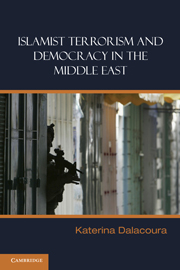Book contents
- Frontmatter
- Contents
- Acknowledgements
- Introduction: The Book's Central Question and Rationale
- 1 Terrorism, Democracy and Islamist Terrorism
- 2 Transnational Islamist Terrorism: Al Qaeda
- 3 Islamist Terrorism and National Liberation: Hamas and Hizbullah
- 4 Islamist Terrorism in Domestic Conflicts: The Armed Islamic Group in Algeria and the Gamaa Islamiya in Egypt
- 5 Moderation and Islamist Movements in Opposition: The Jordanian Muslim Brotherhood/Islamic Action Front, the Egyptian Muslim Brotherhood and the Tunisian Nahda
- 6 Islamist Moderation and the Experience of Government: Turkey's Welfare and Justice and Development Parties and the Islamic Republic of Iran
- Conclusion
- Bibliography
- Index
4 - Islamist Terrorism in Domestic Conflicts: The Armed Islamic Group in Algeria and the Gamaa Islamiya in Egypt
Published online by Cambridge University Press: 05 June 2012
- Frontmatter
- Contents
- Acknowledgements
- Introduction: The Book's Central Question and Rationale
- 1 Terrorism, Democracy and Islamist Terrorism
- 2 Transnational Islamist Terrorism: Al Qaeda
- 3 Islamist Terrorism and National Liberation: Hamas and Hizbullah
- 4 Islamist Terrorism in Domestic Conflicts: The Armed Islamic Group in Algeria and the Gamaa Islamiya in Egypt
- 5 Moderation and Islamist Movements in Opposition: The Jordanian Muslim Brotherhood/Islamic Action Front, the Egyptian Muslim Brotherhood and the Tunisian Nahda
- 6 Islamist Moderation and the Experience of Government: Turkey's Welfare and Justice and Development Parties and the Islamic Republic of Iran
- Conclusion
- Bibliography
- Index
Summary
Terrorism is often employed alongside other violent methods in the context of domestic insurgencies against incumbent regimes, heightened domestic conflict and civil war. The boundaries between terrorism and these other forms of conflict are rarely clearly demarcated, and as we have already seen from the previous chapters, Islamist terrorism is no exception to this pattern. Two further groups in the Middle East which used terrorist tactics as part of a wider violent insurrection are the Armed Islamic Group (Groupe Islamique Armé, GIA) in Algeria and the Islamic Group (Gamaa Islamiya) in Egypt during the 1990s. The similarities between the two cases are numerous, although the scale of the two conflicts was very different. The total number of deaths for Egypt has been given as approximately 1,300 whereas for Algeria it was estimated to be between 150,000 and more than 200,000. The high death toll in Algeria and the type of conflagration which caused it has led analysts to describe this conflict as a ‘civil war’. Others reject this description. Although I recognise the difficulties of defining the term ‘civil war’, I have opted not to apply it to the Algerian context (or indeed the Egyptian one). I therefore place the indiscriminate targeting of civilians in both the Algerian and Egyptian cases under the label of ‘terrorism’ rather than a violation of non-combatant immunity. This is in full awareness of the problems associated with these terms as discussed at some length in the Introduction.
- Type
- Chapter
- Information
- Islamist Terrorism and Democracy in the Middle East , pp. 97 - 122Publisher: Cambridge University PressPrint publication year: 2011



